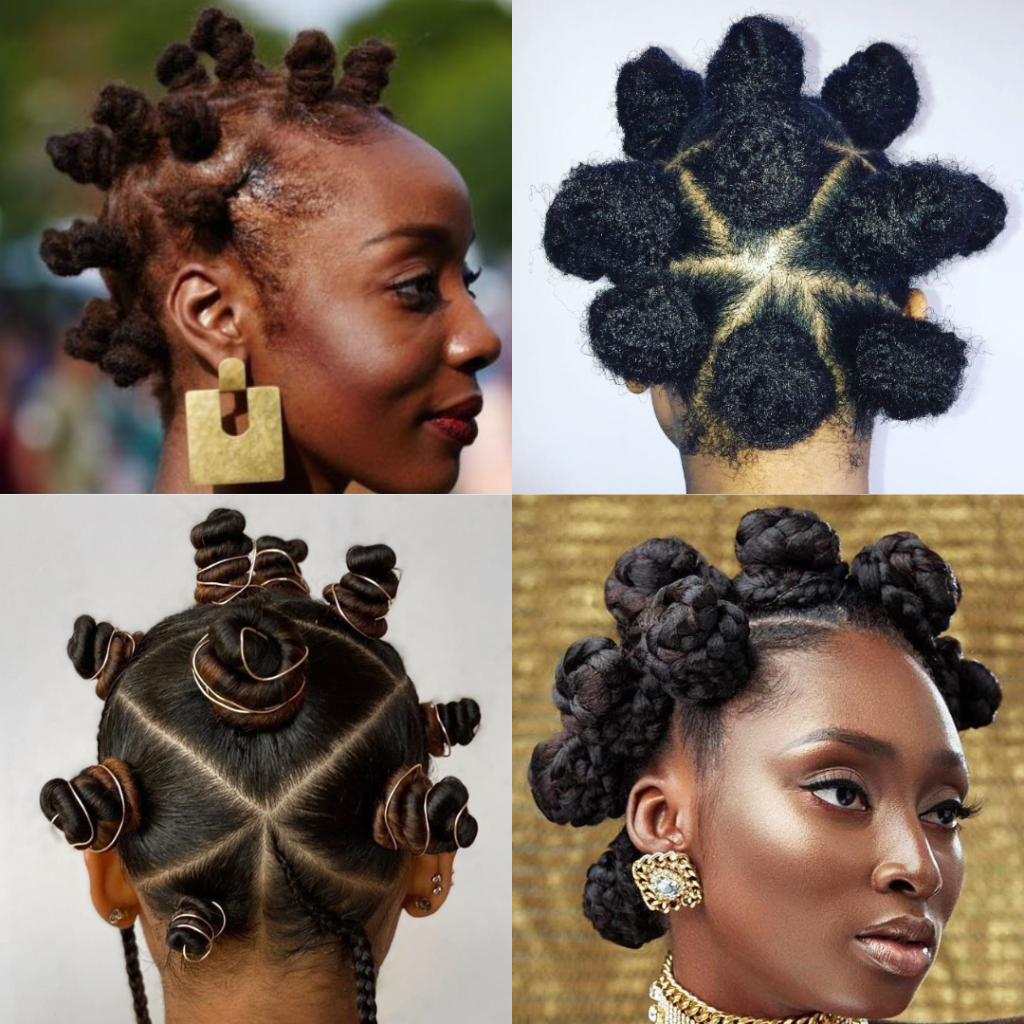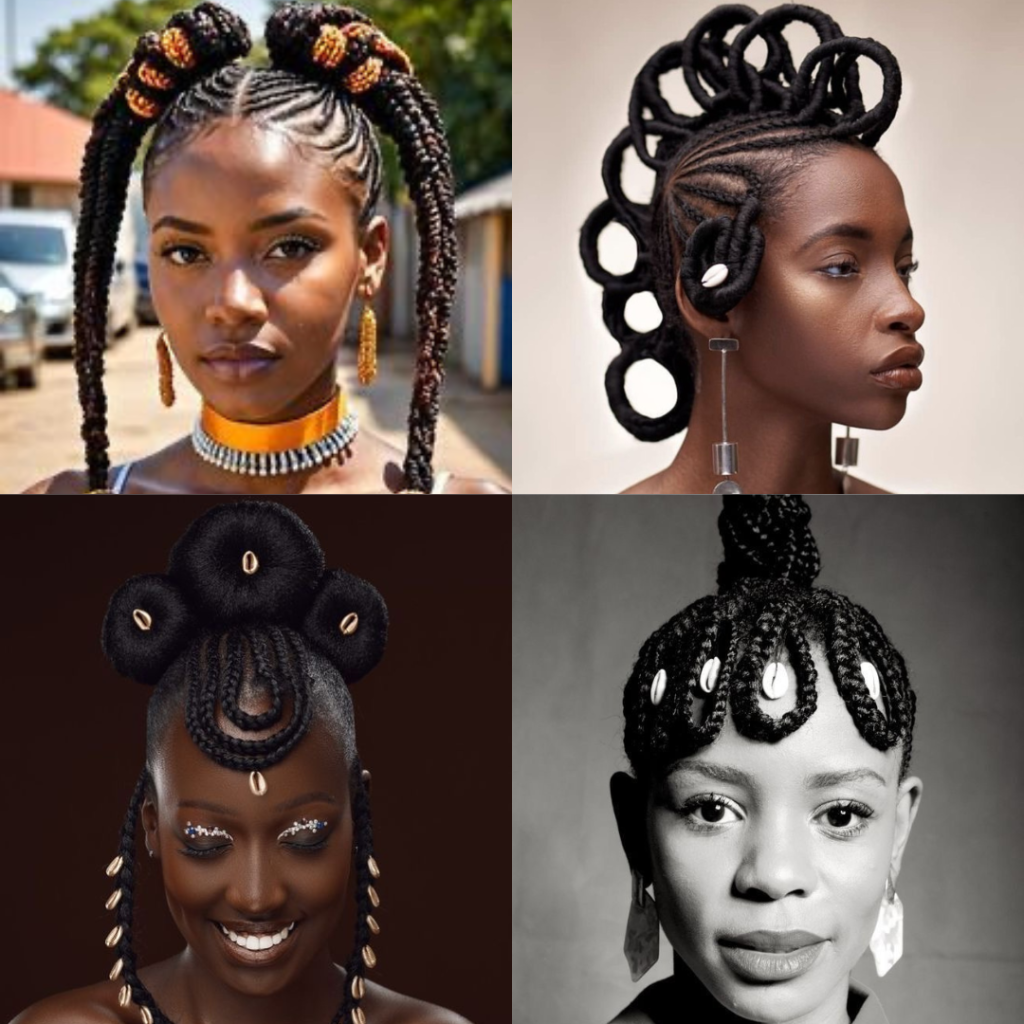From the bustling markets of West Africa to the remote villages of East Africa, traditional hair braiding techniques have long been integral to African culture. Each braid tells a story, reflecting the unique heritage and identity of its people. Let’s explore the diverse and vibrant world of Traditional African Hair Braiding.
West Africa: Cornrows and Fulani Braids
Cornrows (Canerows)

Technique: Cornrows are one of the oldest and most traditional African braiding styles. The technique involves parting the hair into sections and braiding each section closely to the scalp in a continuous, raised row. Additionally, the braids can be arranged in straight lines or intricate geometric patterns, often incorporating designs such as zigzags, swirls, and curved lines.
Historical Context: Cornrows date back thousands of years, with evidence found in ancient African civilizations like Egypt. They were practical hairstyles and also forms of social and religious expression. In some communities, the style of cornrows indicated an individual’s tribal affiliation, marital status, age, wealth, and even religious beliefs.
Significance:
- Practical Use: Cornrows protect the hair by minimizing manipulation and exposure to environmental factors, reducing breakage, and promoting growth.
- Cultural Expression: The patterns and styles of cornrows convey messages about the wearer’s identity, including their social status, community ties, and personal style.
- Modern Influence: Today, people worldwide celebrate cornrows as a symbol of African heritage. Celebrities and influencers frequently adopt this style in modern fashion and pop culture.
Fulani Braids

Technique: Fulani braids, named after the Fulani (or Fula) people of West Africa, feature delicate, thin braids adorned with beads, cowrie shells, and other decorative elements. Typically, these braids include a central parting with braids swept to the sides and often a single braid running down the middle of the head or framing the face.
Historical Context: The Fulani people have a rich cultural history, and their braiding techniques have been passed down through generations. The use of beads and shells in the braids not only adds decoration but also carries cultural and spiritual significance, often reflecting the wearer’s status, wealth, and beauty ideals.
Significance:
- Cultural Identity: Fulani braids symbolize beauty, cultural identity, and pride within the Fulani community. They link individuals to their heritage and showcase their personal and cultural identity.
- Aesthetic Appeal: The intricate braiding patterns and use of accessories make Fulani braids visually striking and unique, contributing to their popularity both in traditional settings and contemporary fashion.
East Africa: Maasai Braids
Maasai Braids

Technique: Maasai braids involve creating thick, intricate braids often dyed with red ochre and adorned with colorful beads. The process includes sectioning the hair and braiding it tightly, sometimes incorporating extensions to add length and volume. The Maasai use red ochre (a natural clay pigment) to symbolize earth and blood, which are vital elements in their culture.
Historical Context: The Maasai people of Kenya and Tanzania are renowned for their distinctive hairstyles and adornments. Hair braiding and decoration are important aspects of Maasai culture, often signifying different stages of life, such as transitions from childhood to adulthood or the achievement of warrior status.
Significance:
- Identity and Status: For the Maasai, braids symbolize identity, social status, and cultural pride. Different braiding styles and decorations indicate a person’s age, gender, and social standing within the community.
- Ritual and Tradition: Braiding plays a role in important cultural rituals and ceremonies, reinforcing social bonds and cultural continuity.
Central Africa: Bantu Knots and Beyond
Bantu Knots

Technique: Bantu knots form by sectioning the hair and twisting each section into tight, small coiled knots. The technique involves parting the hair into small sections, twisting each section tightly, and then wrapping it around itself to form a knot. These knots can be left in or unraveled for a curly hairstyle.
Historical Context: Bantu knots are traditional among various Bantu-speaking ethnic groups in Central and Southern Africa. The style is an essential part of the cultural practices and aesthetics of these communities.
Significance:
- Protective Style: Bantu knots are protective styles that minimize hair manipulation and breakage, promoting healthy hair growth.
- Symbol of Heritage: They symbolize beauty and cultural heritage among the Bantu ethnic groups, reflecting the rich cultural diversity and history of the region.
- Versatility: Bantu knots offer versatility, providing both a unique hairstyle when worn as knots and beautiful curls when unraveled.
Southern Africa: Zulu Braid Patterns and More
Zulu Braid Patterns

Technique: Zulu braids are thick and intricate, often adorned with beads and shells. The technique involves sectioning the hair and braiding it into intricate patterns and designs. They frequently feature geometric shapes. These braids often feature colorful beads and shells, enhancing their aesthetic appeal.
Historical Context: The Zulu people of South Africa have a rich cultural history, and their braiding styles are an important part of their identity. Hair braiding and decoration have been in practice for generations, reflecting social and cultural values.
Significance:
- Cultural Identity: Zulu braid patterns reflect the cultural identity and heritage of the Zulu people. They wear them with pride and the braid patterns serve as symbols of cultural pride and tradition.
- Artistic Expression: The intricate patterns and use of decorations showcase the artistic skill and creativity of the braiders. This contributes to the visual and cultural richness of Zulu hairstyles.
In conclusion, Traditional African Hair Braiding is more than just a hairstyling technique; it celebrates heritage, identity, and pride. Each braid carries centuries of tradition and storytelling, linking the past to the present.
By embracing these techniques, we not only honor our ancestors but also ensure that the beauty and significance of African hair braiding are recognized and respected worldwide.
Hugs and Kisses,
Msglam.






Leave a Comment